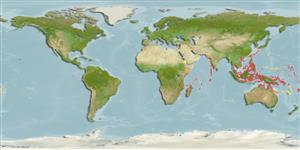Common names from other countries
>
Kurtiformes (Nurseryfishes, cardinalfishes.) >
Apogonidae (Cardinalfishes) > Apogoninae
Etymology: Fibramia: Latin 'fibra' meaning thread or filament and the feminine Greek 'amia' often applied as an ending for some cardinalfish genera as well as an incorrect past usage as a cardinalfish genus. The name refers to two characteristics of the species in this genus, an elongate second dorsal spine in one species and the narrow, pale or dark mid-line on the body of two species..
More on author: Bleeker.
Environment: milieu / climate zone / depth range / distribution range
Ecologie
marien; zoet water; brak water rifbewoner; diepte 2 - 5 m (Ref. 11890). Tropical; 32°N - 23°S
Indo-West Pacific: Zanzibar (Tanzania) eastward to Southeast Asia, and north to Amami-ôshima (Japan) southward to Taiwan, Palau, Philippines and New Guinea east to the Solomon Island and New Caledonia.
Grootte / Gewicht / Leeftijd
Maturity: Lm ? range ? - ? cm
Max length : 7.0 cm SL mannelijk / geslacht onbekend; (Ref. 7050)
Dorsale stekels (totaal) : 7; Dorsale zachte stralen (totaal) : 9; Anale stekels: 2; Anale zachte stralen: 8. Distinguished by having the following characteristics: dorsal-fin rays VI-I, 9; anal-fin rays II, 8; pectoral-fin rays 14; pelvic-fin rays I, 5; pored lateral-line scales 24; predorsal scales 7; circumpeduncular scales 12; total gill rakers 21-22, developed gill rakers 19-20; light brown body; two black stripes, one from snout to opercular margin through eye, and the second one on anterior portion of lateral line; blackish anterior part of first dorsal fin; base of caudal-fin with distinct black spot (Ref. 93839).
Found in brackish water at river mouths and among the mangroves. Also enters freshwater during low tide. Mouth brooding by males (Ref. 559).
Levenscyclus en paargedrag
Maturities | Voortplanting | Spawnings | Egg(s) | Fecundities | Larven
Mouthbrooders (Ref. 240). Distinct pairing during courtship and spawning (Ref. 205).
Masuda, H., K. Amaoka, C. Araga, T. Uyeno and T. Yoshino, 1984. The fishes of the Japanese Archipelago. Vol. 1. Tokai University Press, Tokyo, Japan. 437 p. (text). (Ref. 559)
Status op de Rode Lijst van het IUCN (Ref. 130435)
CITES (Ref. 128078)
Not Evaluated
Gevaar voor de mens
Harmless
Gebruik door de mens
Tools
Speciale rapporten
Download XML
Internetbronnen
Estimates based on models
Preferred temperature (Ref.
115969): 25.4 - 29.3, mean 28.7 (based on 1895 cells).
Fylogenetische diversiteitsindex (Ref.
82804): PD
50 = 0.6250 [Uniqueness, from 0.5 = low to 2.0 = high].
Bayesian length-weight: a=0.01479 (0.00690 - 0.03171), b=3.09 (2.91 - 3.27), in cm Total Length, based on LWR estimates for this (Sub)family-body shape (Ref.
93245).
Trofisch niveau (Ref.
69278): 3.7 ±0.5 se; based on size and trophs of closest relatives
Weerstandsvermogen (Ref.
120179): Hoog, minimale populatieverdubbelingstijd minder dan 15 maanden (Preliminary K or Fecundity.).
Fishing Vulnerability (Ref.
59153): Low vulnerability (10 of 100).
